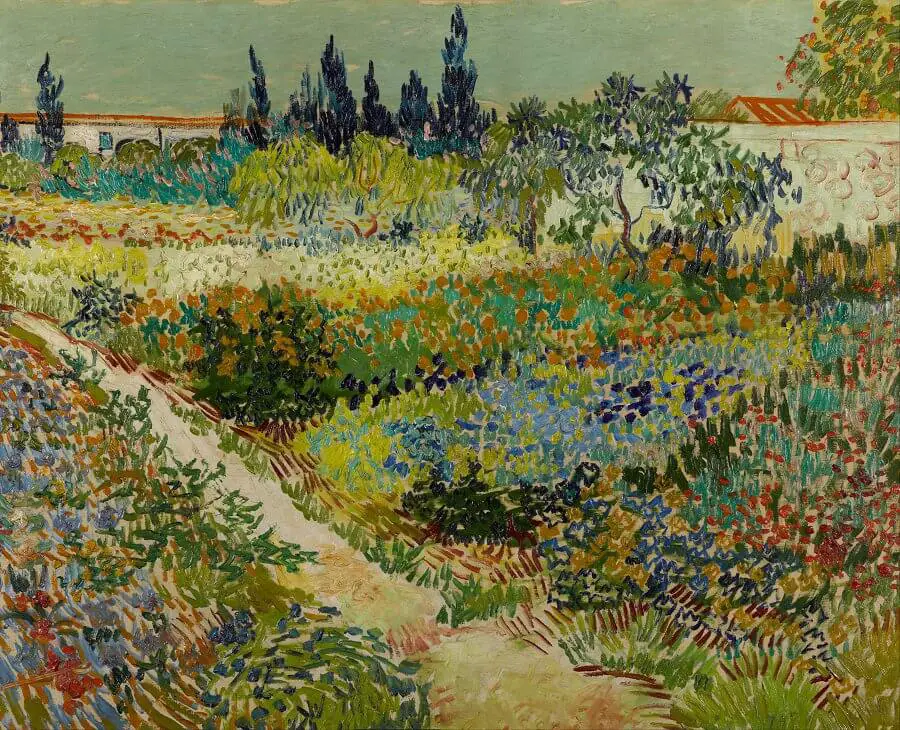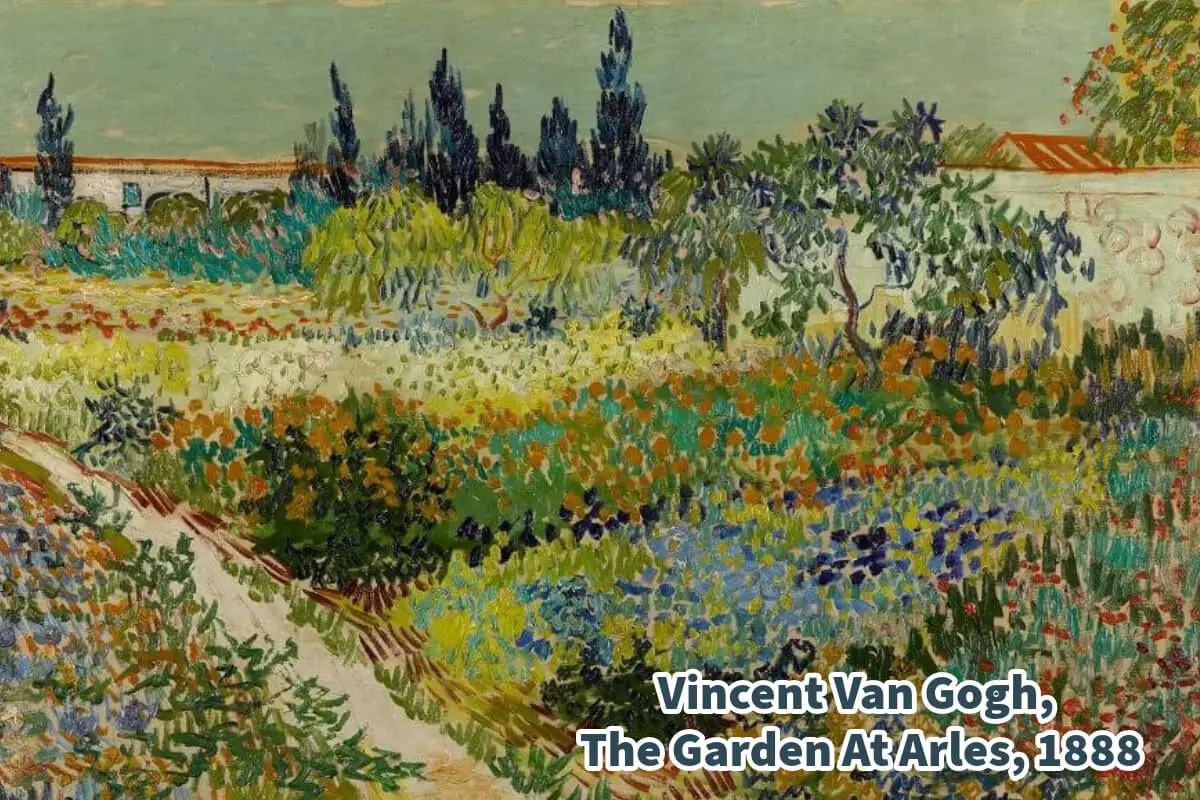Vincent Van Gogh Is one of my favorite artists. Vincent Van Gogh, undoubtedly one of the greatest artists in history, is celebrated for iconic works like “The Starry Night” and his captivating “Sunflower Collection.”
However, amidst his illustrious portfolio, Van Gogh also turned his attention to the beauty of garden scenes. In 1888, he created “The Garden at Arles.” Join us as we delve deeper into the captivating world of this iconic painting.
Table of Contents
- “The Garden At Arles, 1888” By Vincent Van Gogh: A Masterpiece Of Creativity And Innovation
- Related Questions
“The Garden At Arles, 1888” By Vincent Van Gogh: A Masterpiece Of Creativity And Innovation
Vincent van Gogh, one of the most celebrated artists in the history of Western art, created many masterpieces during his tragically short life. Among his vast work, “The Garden at Arles, 1888” stands as a testament to his unique artistic vision and willingness to experiment with different techniques and styles.
Read on as we delve into the fascinating world of this painting, exploring its historical context, Van Gogh’s creative process, and the artistic techniques that make it a masterpiece.
The Garden At Arles: A Glimpse Into Van Gogh’s Artistic Process
“The Garden at Arles, 1888” is one of two paintings Van Gogh created of the garden at Arles in the same month. This rapid production of multiple versions of the same motif was not uncommon for Van Gogh.

He often painted a subject repeatedly, capturing it at different times of the day and under varying lighting conditions. Impressionists profoundly influenced this approach, obsessed with conveying the ever-changing play of light on their subjects.
Van Gogh’s fascination with this technique gives us unique insight into his creative process.
It allows us to witness his ideas’ evolution and his artistic vision’s development. It’s as if we are given a glimpse into his mind, observing how he approached a subject from different angles and at different moments.
The Decorative Feel: Experimenting With Pointillism
One of the striking features of “The Garden at Arles, 1888” is its decorative quality. Van Gogh’s experimentation with Pointillism, a technique championed by his friends Paul Signac and Georges Seurat, is evident in this painting.
Instead of using long, sweeping brushstrokes as in some of his earlier works, Van Gogh opted for small, short brushstrokes loaded with pure and brilliant colors.
Every brushstroke in this painting serves a purpose in the overall design. The controlled application of color creates a visual tapestry that is both mesmerizing and harmonious.
Unlike some of his contemporaries who adhered to strict Pointillist principles, Van Gogh blended his unique style with the technique. The result is a work of art that balances the intricacies of Pointillism with his expressive and emotional approach to painting.
Beyond Pictorial Reality: Van Gogh’s Unique Vision
One of the hallmarks of Van Gogh’s art is his ability to transcend mere pictorial representation. In “The Garden at Arles, 1888,” we see Van Gogh’s signature drawing style with paint.
He didn’t rely on traditional underdrawings or sketches; instead, he allowed the paint itself to guide his creative process. This approach gives his works an unmatched sense of spontaneity and vitality.
The garden in this painting is not merely a faithful depiction of a physical place; it represents Van Gogh’s emotional connection to the scene. The vibrant colors, the swirling brushstrokes, and the dynamic composition convey his inner turmoil and passion.
Van Gogh’s art goes beyond realism; it captures his subjects’ essence and state of mind.
The Timeless Beauty Of “The Garden At Arles, 1888”
“The Garden at Arles, 1888” by Vincent van Gogh is a masterpiece that continues to captivate art enthusiasts and scholars alike. Its significance lies in its visual appeal and the insight it offers into Van Gogh’s creative journey.
This painting shows the artist’s dedication to exploring different techniques and his unrelenting pursuit of artistic innovation.

Van Gogh’s departure from traditional pictorial reality and his embrace of Pointillism in “The Garden at Arles, 1888” exemplify his willingness to push artistic boundaries. The result is a work of art that transcends time and place, inviting us to experience the world through the eyes of a true visionary.
As we admire this masterpiece, we are reminded of the enduring power of art to communicate complex emotions, capture fleeting moments, and inspire generations of artists and art lovers.
“The Garden at Arles, 1888” is not just a painting; it is a testament to the indomitable spirit of Vincent van Gogh and his lasting impact on the art world.
Anita Louise Art is dedicated to art education, great artists, and inspiring others to find and create their art. We love art that uplifts and inspires. #ArtToMakeYouSmile! #ArtToMakeYouHappy!
If you want to see any of my art, you can find out more by clicking here. If you are interested in what inspires me and my paintings, you can discover more by clicking here.
We have a free newsletter and would love you to be part of our community; you can subscribe to the newsletter by clicking here. If you have any questions, I would be happy to talk to you anytime. You can reach me, Anita, by clicking here.
Subscribe to our Anita Louise Art YouTube Channel with great videos and information by clicking here.
Join us for our podcast “5 Minutes With Art.” Spend just 5 minutes a week with us to discover and learn about great art and artists. You can find out more about our podcast by clicking here.
Related Questions
The Starry Night Original By Vincent Van Gogh
The Starry Night is one of Vincent Van Gogh’s most important paintings. The Starry Night is such a powerful piece of art as it shows how Van Gogh could produce paintings filled with imagination and emotion. He could produce these paintings even during some of his darkest hours when he was treated for his mental illness.
By clicking here, you can learn more by reading The Starry Night Original By Vincent Van Gogh.
Almond Blossom By Vincent Van Gogh
Almond Blossom by Vincent van Gogh is a painting that he painted for his brother Theo and sister-in-law, Jo, to celebrate the birth of their son Vincent Willem. Vincent Van Gogh painted the Almond Blossom painting in hopes that Vincent Willem would have the painting in his bedroom. The Almond Blossom painting shows the influence of Japanese Woodblock prints on Van Gogh’s artwork.
By clicking here, you can discover more by reading Almond Blossom By Vincent Van Gogh.
The Mysterious Cutting Off Of Vincent Van Gogh’s Ear
Van Gogh and Paul Gauguin lived together in Arles, France, in the Yellow House, but there was a lot of tension between them. One day Vincent Van Gogh had an acute mental illness, so he cut off his ear; he then took his cut-off ear to a local prostitute. This started a series of events that led to the police getting involved and forcing Vincent Van Gogh into the hospital to be treated for mental illness.
By clicking here, you can discover more by reading The Mysterious Cutting Off Of Vincent Van Gogh’s Ear.

